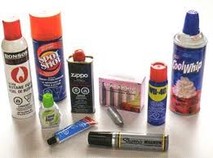Inhalents
Huffing. Sniffing. Bagging. Inhalant abuse takes different forms and is tagged with different slang descriptions, but they all come down to the same thing: inhaling fumes, vapors or gas for the purpose of getting high.
According to the Alliance for Consumer Education's explanation of inhalant abuse, "Huffing is when a chemically soaked rag is held to the face or stuffed in the mouth and the substance is inhaled. Sniffing can be done directly from containers, plastic bags, clothing or rags saturated with a substance or from the product directly. With Bagging, substances are sprayed or deposited into a plastic or paper bag and the vapors are inhaled. This method can result in suffocation because a bag is placed over the individual's head, cutting off the supply of oxygen."
Inhalant use is often the first experiment with illicit drugs for kids. They may believe that it holds little danger, since they are using common household products. But they are wrong.
Dangers
It is every bit as dangerous as alcohol or other drug use. It can lead to addiction, brain damage and death - sometimes on the very first
experience.
Sudden Sniffing Death (SSD) syndrome may cause fatal heart failure. SSD syndrome may result when a user deeply inhales a chemical for the effect of intoxication. This causes a decrease in
available oxygen in the body. If the user becomes startled or engages in sudden physical activity, an increased flow of adrenalin from the brain to the heart induces cardiac arrest and death occurs
within minutes.
Who is Huffing What?
Millions of older children and teens are experimenting with inhalants. The Centers for Disease Control lists inhalants as second only to marijuana for illicit drug use among youth. The opportunity for abuse is huge - more than 1,400 common products have been identified as potential substances for inhalant abuse, including correction fluid, rubber cement, gasoline, butane, glue, marking pens, dusting spray, canned whipped cream and cooking sprays.
Parents Taking Action
While millions of young people either experiment with inhalants or use them on a regular basis, a majority of parents claim their children never huff - maybe because they aren't aware of what to look for or perhaps they are overlooking their children's behavior. Either way, their children are in eminent danger. Parents can arm themselves and help protect their children through education, communication and preparation.
Education includes understanding the dangers of inhalant abuse, familiarizing themselves with the products commonly used, and becoming aware of the signs and symptoms of use.
Communication between parent and child about the dangers of inhalants is vital. It is also
important for parents to share information with other parents, teachers and anyone who may be involved with young people. The more adults who are aware of the danger posed by inhalants, the
more prevention will take place in our communities.
Preparation involves knowing how to respond if your child shows symptoms of inhalant use.
Be aware of the specific signs and symptoms of inhalant abuse, including:
● Painting fingernails with magic markers or correction fluid
● Sitting with a pen or marker by the
nose
●Constantly smelling clothing sleeves
● Showing paint or stain marks on face, fingers or clothing
● Having numerous butane lighters and refills in room, backpack or locker (when the child does not smoke)
● Hiding rags, clothes or empty containers of the potentially abused products in closets, under the bed, in garage etc.
● Drunk, dazed, or dizzy appearance
●Slurred or
disoriented speech
● Uncoordinated physical
symptoms
● Red or runny eyes and nose
● Spots and/or sores around the mouth
● Unusual breath
odor or chemical odor on clothing
● Signs of paint or other products where they wouldn't
normally be, such as on face, lips, nose or fingers
● Nausea and/or loss of appetite
●Chronic Inhalant Abusers may exhibit symptoms such as hallucinations, anxiety, excitability, irritability, restlessness or
anger
Office of National Drug Control Policy - Inhalants Fact Sheet
Partnership for a Drug Free America - Information on Inhalants



